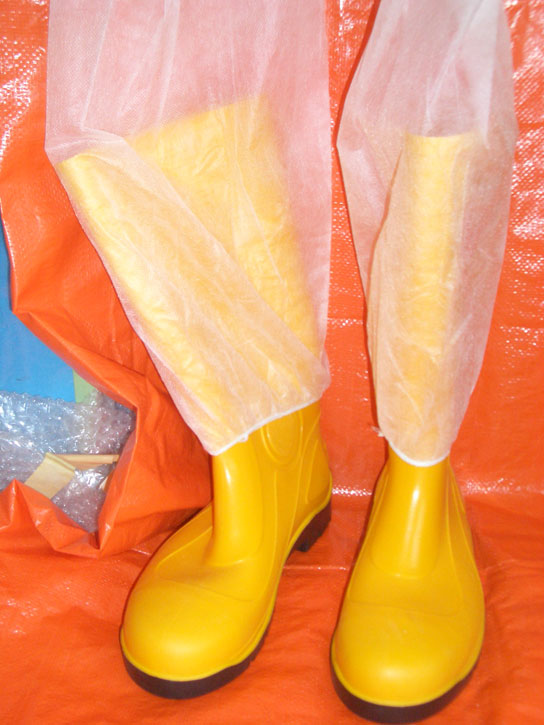
2050 Prishtina
Klaus Schafler
Opening: 31 October 2008, 19:00
31 October 2008 - 29 November 2008
Unbelievable!: Artist talk with Klaus Schafler
1 November 2008, 18:00
2050 Prishtina
[video-projection including sound (DVD), approx. 20 photos, yellow gumboots, plastic box 30x15x10, adhesive letters to put on yellow wall], Stacion center for Contemporary Art, Prishtina (2008).
The transnational project 2050 focuses on Klaus Schafler's vision of sub-/urban space, architecture and living conditions around the year 2050. It reflects upcoming socio-political developments and phenomena, neither governmental structures nor private companies until now would think about as they act in shorter terms.
Gas stations are worldwide (also historically seen) important crystallisation points of a hang- out and transit-culture in sub-/urban areas and in-between spaces. Gas stations, these "other-places" that exist already today, but refer to a certain future, to other possible societal conditions.
The project 2050 works with fictions of utopian gas stations, as experimental settings, interventions or installations. They are given new aesthetics and functions, installed as small and local semi-public spaces, and called according to the reflected phenomena, for instance Freespace Module, Luna Park Module, Ride-Share-Point Module, Calm Module, Refuge Module, Human Rights Module, Translation Module and so on.
The project up to now consists of several modules, realized in different locations and cities using diverse media and formats (installation, intervention in public space, drawings, models, objects, photography, video-film, lectures, etc.). They all combine the overall concept of 2050 with the particular local situation.
The project and exhibition 2050 Prishtina, as a new part of the project 2050, intends to reflect the first and possibly realized utopian gas station in Kosovo in researching on local challenges in Kosovo (geo-political, socio-economic situation, culture) and then showing a specific utopian gas station installation, designed as an autonomous space being part of a shifting transnational framework.
2050 and parts of it were shown in 2005 at K.U.L.M., steirischer herbst (Austria); in 2006 at FIT in Berlin (Ger), in 2007 at LMCC open studio, 120 Broadway, New York (US); at Kuenstlerhaus Vienna (A), at Pocket Utopia, New York (US), at ZAIM in Yokohama (Japan) and recently in 2008 at PM Gallery / HDLU Zagreb (Croatia) and at the Chinese Biennial in Beijing.
Klaus Schafler: 2050 Prishtina is part of Open Call2. Members of the jury that selected the work of Klaus Schafler for Open Call2 were Alban Muja, Bekim Llalloshi dhe Agon Hamza.
Klaus Schafler: 2050 Prishtina for Open Call2 is supported by Bundesministerium fur Unterricht, Kunst und Kulur, Austrian Cultural Forum Belgrade and DZG.
Erwin Fiala in FALTER, city magazine in Vienna, 2006, on the project 2050 by Klaus Schafler:
In a vision of the future, Klaus Schafler draws the picture of the year 2050 as an example of "future centers and places in (sub-) urban regions". His utopian gas stations represent centers of a social and cultural life of a society which since longer has globally networked it's functional organisation and which no longer defines itself through the classical structure of center and periphery.
Centers are becoming diffused into countless intersection points in sufficient density and distribution. The movement energy will disseminate, seperate and freshly connect not in hierarchical, vertical lines rather heterarchically. Simultaneously, these intersection points, as transit-places, as in-between spaces and meanwhiles, will be a datastream of people, occupations, needs and wishes which is flowing through them. Thereby the places will become -in an almost paradoxical manner- connecting elements of connecting lines, equally central as decentral, "Heteropies" as Michel Foucault sketched out. These utopian gas stations will be places without local anchoring or boundary, equally territorial as deterritorial, public and yet private and intimate: in-betweens and semi-publics will constituate in them and again disseminate in streams of communication. These in-between spaces are in the end "intersections that are often not perceived" In a mobile nomadic society, whose architectonic tentacles form the life lines of the mobile being in the form of proliferous street networks, there is a need for the crossing points which can offer in moments of brief pauses the opportunity to orient from-where, to-where, when and why. Non-located territories - Net culture on the road.